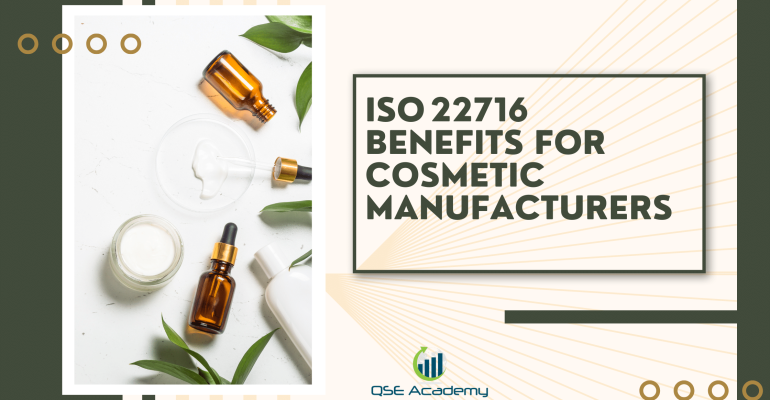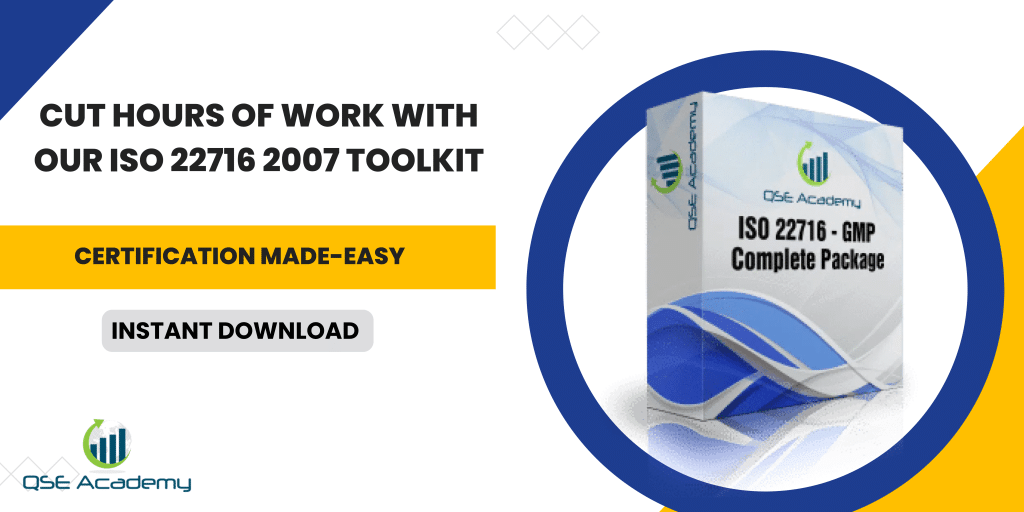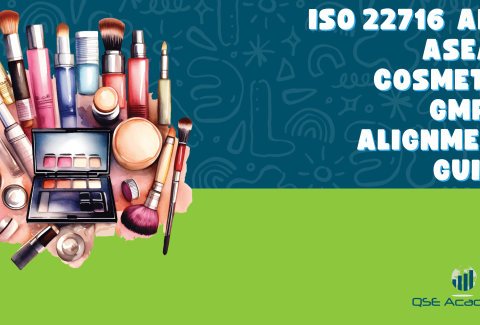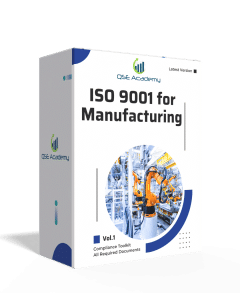ISO 22716 Benefits for Cosmetic Manufacturers
Last Updated on October 24, 2025 by Hafsa J.
Why ISO 22716 Is a Game-Changer for Cosmetic Production
If you’re in the business of making cosmetics, you’ve probably heard that ISO 22716 is the standard for Good Manufacturing Practice (GMP). But here’s what I’ve noticed after helping dozens of cosmetic manufacturers implement it — most don’t fully realize how much value it brings beyond compliance.
ISO 22716 isn’t just a box to tick for regulators. It’s a practical framework that helps you tighten your production, reduce waste, improve product consistency, and earn trust from customers and partners alike. Whether you’re manufacturing skincare, perfumes, or hair products, it’s the system that turns “we make cosmetics” into “we make cosmetics safely, efficiently, and reliably.”
In this article, we’ll break down exactly how ISO 22716 benefits cosmetic manufacturers — from minimizing risk and improving workflow to opening doors for global trade. And yes, we’ll also look at how it can boost your brand reputation and your bottom line at the same time.
Quality and Consistency – Reducing Errors Before They Happen
Every manufacturer wants consistency — the kind where every batch looks, feels, and performs the same way every time. That’s where ISO 22716 quietly works its magic. It gives you structure: clear Standard Operating Procedures (SOPs), documented controls, and repeatable production steps that prevent things from going wrong in the first place.
I’ve seen it firsthand. Once you implement ISO 22716 properly, production errors, contamination issues, and labeling mix-ups drop dramatically. It’s not about creating more paperwork; it’s about creating a system that catches problems before they reach your customers.
The standard pushes you to look at the fine details — how raw materials are stored, how equipment is cleaned, and how deviations are logged and corrected. When every step is traceable, you gain real control over product quality.
Pro tip: Use your internal ISO 22716 audits as opportunities to identify inefficiencies. Don’t just focus on what’s noncompliant — look for what slows you down or creates rework.
Common pitfall: Some manufacturers treat GMP records as paperwork for the auditor instead of as a diagnostic tool. Those forms are early-warning sensors — they show you where quality starts slipping before it becomes a costly recall.
Example: One of my clients, a mid-sized skincare producer, reduced batch rejects by nearly 40% simply by tightening their cleaning validation process. They didn’t add new machines — they just followed their ISO 22716 logs more closely and spotted a trend before it spiraled.
When you think about it, ISO 22716 doesn’t just improve your quality system — it builds consistency you can measure and trust.
Market Access & Regulatory Confidence – The Ticket to Global Trade
Here’s something most manufacturers discover the hard way — you can’t sell in the EU or most major markets without proving you follow Good Manufacturing Practice (GMP). And ISO 22716 is the language regulators everywhere understand.
Under EU Regulation 1223/2009, GMP isn’t optional — it’s mandatory. ISO 22716 just happens to be the officially recognized reference standard for showing that your production meets those requirements. That’s why certification (or even documented compliance) gives your company instant credibility when dealing with authorities, distributors, or brand partners.
Outside Europe, it’s no different. Markets like ASEAN, GCC (Gulf), and ANVISA (Brazil) accept ISO 22716 as their go-to benchmark for GMP. I’ve helped clients use one ISO 22716 certification to open doors to five or more markets — without having to redo their audits for each region.
Pro tip: Make ISO 22716 part of your export strategy. Having that certificate ready can shorten your approval timeline when negotiating with new distributors or retailers. They’ll trust you faster because you’re already meeting internationally recognized standards.
Common pitfall: Many companies assume passing a local health inspection means they’re globally compliant. It doesn’t. Local inspectors focus on hygiene and safety, but ISO 22716 adds structure, traceability, and repeatability — the kind of proof global buyers and regulators expect.
Example: A UAE-based manufacturer I worked with leveraged their ISO 22716 certification to expand into 12 EU countries. They didn’t have to go through multiple inspections — the certificate did the talking.
Bottom line? ISO 22716 isn’t just about quality control — it’s your passport to global trade.
Operational Efficiency – Streamlining Workflows and Reducing Waste
When I walk into a factory that’s just implemented ISO 22716, I can usually spot the change immediately — cleaner workspaces, better documentation flow, and fewer production bottlenecks. It’s not magic; it’s what happens when you introduce structure.
ISO 22716 pushes you to define every process clearly — who does what, how it’s done, and how it’s verified. Once those roles and routines are documented, you start catching inefficiencies that were invisible before. Maybe raw materials sit too long between weighing and mixing. Maybe maintenance isn’t scheduled often enough, leading to equipment downtime. GMP doesn’t just tell you to fix these issues — it gives you the tools to see them.
Pro tip: Combine ISO 22716 with ISO 9001 principles to streamline operations even further. You’ll eliminate redundant records and standardize your workflows without extra bureaucracy.
Common pitfall: Writing procedures no one actually follows. I’ve seen manufacturers with immaculate manuals — but the shop floor tells a different story. Involve your operators when writing SOPs. They know what works and what doesn’t, and when they help build the process, they’ll own it.
Example: A cosmetics plant I worked with in Poland used ISO 22716 implementation as an opportunity to align its maintenance and batch-release schedules. The result? Equipment downtime dropped by 25%, and their overall production flow became smoother and faster.
ISO 22716 isn’t just about passing audits — it’s about building a smarter, leaner, and more efficient manufacturing system that pays for itself over time.
Risk Management & Consumer Safety – Preventing Costly Recalls
If there’s one thing every manufacturer dreads, it’s a product recall. They’re expensive, damaging, and hard to recover from. The good news? ISO 22716 helps you prevent most of them before they ever happen.
The standard forces you to think about risk at every stage — from raw material handling and packaging control to storage, labeling, and final product release. You’re not just reacting to problems anymore; you’re actively scanning for weak points before they can hurt you.
In my experience, the manufacturers who take ISO 22716 seriously develop a sixth sense for potential issues. They don’t just record deviations; they investigate them, learn from them, and strengthen the system. That’s what true risk management looks like.
Pro tip: Treat your deviation log as a learning tool, not a blame list. Every near-miss is an opportunity to improve your process and prevent something bigger down the road.
Common pitfall: Ignoring small quality variations because “nothing bad happened.” Regulators and clients see that as weak risk management. A small inconsistency in preservative dosage or temperature control might not cause immediate harm, but it chips away at your reliability.
Example: A UK-based skincare lab I supported caught a formulation issue early thanks to ISO 22716’s batch record review process. Their preservative concentration was slightly off — not enough to fail testing, but enough to raise a flag. They corrected it before shipping and avoided what could’ve been a €20,000 recall.
At the end of the day, ISO 22716 isn’t about paperwork — it’s about protecting your consumers and your brand’s reputation. You can fix a process, but rebuilding trust after a recall? That takes years.
Brand Trust & Client Confidence – Turning Compliance into Marketing Power
Here’s something I tell every client: compliance isn’t just about keeping regulators happy — it’s a trust signal. ISO 22716 can be one of the most powerful marketing tools a cosmetic manufacturer has, if you know how to use it.
When you’re ISO 22716-certified (or can prove compliance), you’re essentially telling partners and consumers, “Our products are made under internationally recognized GMP conditions.” That statement carries weight. It reassures retailers, private-label clients, and even investors that your products are safe, traceable, and professionally managed.
Pro tip: Train your sales and marketing teams to talk about ISO 22716 the right way. Don’t just list it on your website — explain what it means: cleaner facilities, safer production, documented traceability, and better quality control. It turns what’s usually “compliance speak” into a competitive advantage.
Common pitfall: Many manufacturers earn certification but never leverage it. They treat it like a quiet internal achievement instead of showcasing it in tenders, export documents, and client proposals. In B2B cosmetics, transparency builds trust — and trust builds long-term contracts.
Example: One of my clients, a contract manufacturer in Spain, added ISO 22716 details to their distributor onboarding kits and saw a 35% increase in partnership conversions. Buyers loved the simplicity: all compliance proof in one place, no follow-up questions.
In today’s market, quality isn’t just measured by how a product looks — it’s measured by how it’s made. ISO 22716 tells the world you take both seriously.
Continuous Improvement – Building a Culture That Outlasts Audits
One of the biggest hidden benefits of ISO 22716 is how it quietly reshapes your company culture. It’s not just about documentation or passing audits — it’s about creating a mindset of continuous improvement across every department.
I’ve watched manufacturing teams evolve once they start treating ISO 22716 as more than a set of rules. Suddenly, operators take pride in spotless production areas, supervisors review data with curiosity instead of fear, and management meetings focus on preventing problems rather than reacting to them. That’s when GMP starts paying off in ways no certificate ever could.
Pro tip: Celebrate small improvements. When an internal audit catches a minor issue early or a team suggests a smarter storage layout — highlight it. Those wins build engagement and reinforce that ISO 22716 is about making work easier and safer, not harder.
Common pitfall: Viewing audits as yearly chores instead of ongoing health checks. If you only review processes before inspection day, you’re missing the point. The real value comes from tracking progress, adjusting procedures, and training staff continuously.
Example: A French cosmetics manufacturer I worked with began using internal audit data to identify recurring packaging issues. Instead of blaming staff, they reorganized the storage area and improved lighting. The result? Fewer mix-ups, happier employees, and smoother production — all sparked by one ISO 22716 review.
ISO 22716 doesn’t just help you meet today’s standards; it builds a culture that keeps improving year after year.
FAQs – Quick Answers for Manufacturers
1. Does ISO 22716 certification guarantee compliance with EU 1223/2009?
Not entirely — but it gets you most of the way there. ISO 22716 covers the Good Manufacturing Practice (GMP) portion of EU 1223/2009 (Article 8), which is a major compliance requirement. However, full compliance also means meeting labeling, product safety, and documentation obligations. Think of ISO 22716 as your operational proof — the strong foundation regulators expect to see.
2. How long does it take to implement ISO 22716?
From what I’ve seen, small manufacturers can be audit-ready in about 3–6 months, while larger or multi-site operations may need up to a year. The real timeline depends on how organized your existing systems are. If you already have clear SOPs, batch records, and traceability systems in place, you’re halfway there.
3. Is certification worth it for small producers?
Absolutely. Even if you decide not to get certified, following ISO 22716 principles will still strengthen your quality control and documentation. It makes your business more professional, builds client confidence, and prepares you for future growth. Many boutique brands land private-label or export deals specifically because they can demonstrate GMP compliance.
Quality, Trust, and Growth Start with GMP
Here’s the thing — ISO 22716 isn’t just another requirement to satisfy your regulator or buyer. It’s a system that transforms how your manufacturing operation runs day to day. Once you adopt it, you start to notice fewer errors, cleaner handovers, smoother audits, and a stronger sense of ownership across your team.
In my experience, the companies that benefit most from ISO 22716 are the ones that use it as a growth tool, not just a compliance shield. They use their GMP framework to open new markets, strengthen brand credibility, and attract bigger partnerships. It’s quality management in action — and it pays off in both reputation and revenue.
Pro tip: Don’t wait for a client to ask if you’re GMP-compliant. Make ISO 22716 part of your brand story. It shows you care about safety, consistency, and integrity — values that customers recognize instantly.
At QSE Academy, we’ve guided countless cosmetic manufacturers through ISO 22716 implementation and certification, helping them turn compliance into a competitive edge. If you’re ready to see what it can do for your business, download our “ISO 22716 Implementation & Benefits Guide” and start building a safer, more efficient, and globally trusted cosmetic production system.
Because in this industry, quality isn’t an expense — it’s your advantage.
Whether it’s ISO 9001, ISO 22000, or the cosmetics-focused ISO 22716, I’ve spent my career I’m not here to call myself an expert—I prefer “enthusiast” because I truly love what I do. When I’m not writing about standards, you’ll probably find me playing Piano 🎹, connecting with people, or diving into my next big project💫. I’m an engineer specialized in the food and agricultural industry
make ISO standards less intimidating and more approachable for everyone.
turning complex jargon into clear, actionable steps that businesses can actually use.
There’s something incredibly rewarding about helping people navigate food safety and quality management systems
in a way that feels simple, practical, and even enjoyable.
I have a Master’s in QHSE management and over 12 years of experience as a Quality Manager
I’ve helped more than 15 companies implement ISO 9001, ISO 22000, ISO 22716, GMP, and other standards
My clients include food producers, cosmetics manufacturers, laboratories, and service companies
I believe quality systems should be simple, useful, and efficient.











